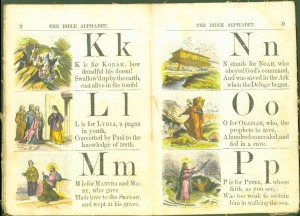
Carey MacDonald is an undergraduate Anthropology major and writing intern. In her blog series Through the Lens of an Anthropologist, Carey analyzes artifacts found in the collections of Archives and Special Collections.
People, like parents and teachers, and things, like games and books, play significant roles in shaping a child’s understanding of the world. According to the Cambridge Guide to Children’s Books in English (“Alphabet Books” by Ann Rowe), alphabet books in particular have been in use since the 15th century to teach the alphabet to young children to prepare them for learning to read. The first alphabet books were called primers and were essentially prayer books that dedicated several pages to the alphabet. ABC books eventually became separate books from primers and utilized illustrations and short rhymes to represent each specific letter. We can see how the ABC books we know today came to be by looking into the wide-ranging collection of alphabet books in the Archives.
One such book from 2008, called “Z is for Zeus: A Greek Mythology Alphabet” and written by Helen L. Wilbur and illustrated by Victor Juhasz, comes in a large, hardcover picture book form with a plastic overlay. The beginning pages are filled with information about how Greek mythology is useful in modern times. The “Why It’s Greek to You” section describes this when it says, “By reading and studying the myths and their culture you can expand your understanding of the words, their meanings, and symbols, making them no longer Greek to you.”
This section also explains that the names of many modern-day words, places, products, companies, and organizations are derived from Greek mythology. Nike, for instance, is known as an athletic apparel brand to us but was originally known as the Goddess of Victory to the ancient Greeks. After introducing the relevance of myths to today’s world, the book continues by aligning letters of the English alphabet with various aspects of Greek mythology. Each letter is reflected in a finite, four-line poem that is written in a typical, sing-song AABB rhyme scheme. Historical explanations of each letter’s representative word are also provided on each page. Whimsical, colorful, caricature-like illustrations further describe the represented letter. The people’s exaggerated facial features – particularly their big eyes and noses – would be comical to a child and thus captive of his or her interest.
Furthermore, the letters symbolize such curious things as gods and goddesses, for the letter G, who reside in Olympus, for the letter O, as well as Sirius, the brightest star in the sky, for the letter S. By remarking on such intangible, ambiguous, and distant things as god(s) and the constellations, this alphabet book brings into focus two difficult subjects of human conjecture which a child, as we can imagine, can only understand to a limited extent.
Other letters symbolize character traits; for instance, the letter H is represented by heroes and the heroic qualities that children are taught to demonstrate: “Fearless deeds are just one part of the heroic creed. You must have heart, nobility, show reverence, and strive in all for excellence.” Similarly, the letter K is represented by King Midas in that “King Midas will tell you if you’re very bold and ask that all you touch turns to gold, what seems like a blessing will make you feel cursed.” Still other letters attempt to explain the origin of humans.  For instance, from Chaos, for the letter C, “came the earth and the heavens, the ocean and light,” and the Fates, for the letter F, “determine at your birth your length of time upon this earth.”
For instance, from Chaos, for the letter C, “came the earth and the heavens, the ocean and light,” and the Fates, for the letter F, “determine at your birth your length of time upon this earth.”
Like this alphabet book from 2008, a hard paper alphabet primer from 1913, which is entitled “The Noah’s Ark Primer” and was produced by the G.C. Hanford Manufacturing Company of Syracuse, New York and distributed by “druggist” U.C. Becker, is written in an AABB rhyme scheme and aligns the letters of the alphabet with the animals described by the Bible to be found on Noah’s Ark during the biblical deluge. Another primer, “The Bible Alphabet,” published in 1860 by Sheldon & Co. of New York, New York, differs from the 20th and 21st century books in that it is made of cloth and is written in ABCB rhyme scheme. It is similar however, particularly to the 1913 book, in that it aims to teach children the English alphabet while also introducing them to Biblical figures.
In essence, each of these alphabet books functions as an educational tool both scholastically and culturally. While the format and structure has changed over time, the basic, instructive premise of the alphabet book has remained the same. It is apparent that, since these books have been in production for the past six-hundred years, the instructional template of the alphabet book is timeless.
Carey MacDonald, writing intern
